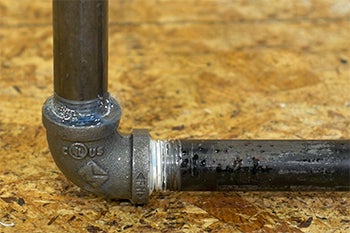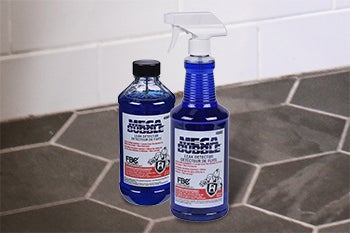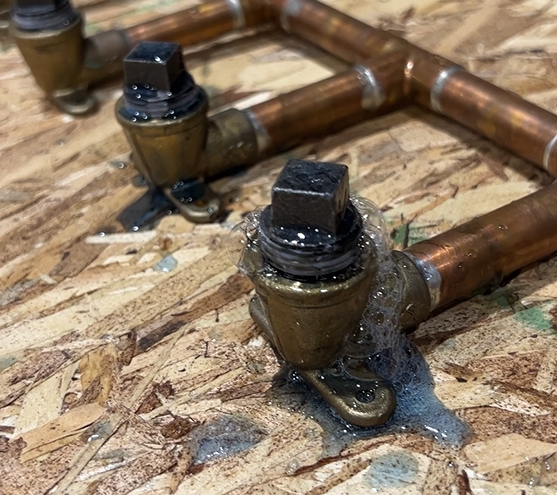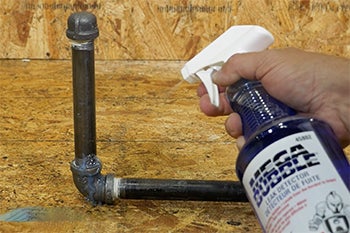If you suspect a gas leak in your home’s piping system or if you are a trade professional whose gauge detected a leak during a pressure-test on a new piping rough-in, a pipe leak detector is a fast and easy way to find a pipe leak.
Below we share what a pipe leak detector is, when to use it, and four easy steps to apply it.
What is a pipe leak detector, and how does it work?
Pipeline testing determines if and, in some cases, where a leak has occurred in systems that contain gases or liquids. Common leak-test methods are pressure and vacuum decay, tracer gas detectors, and a bubble soap leak detector.
Trades and homeowners alike can use a bubble soap leak detector to check piping systems for leaks. Often referred to as "soaping" the joint, this leak-detection process involves applying a soap liquid or mixture to pipe joints. As the pressure inside the pipe leaves the joint, bubbles will form if there is a leak.

A leak detector like Hercules® Megabubble® uses a high-viscosity formula that produces large, long-lasting blue bubbles to quickly detect leaks on pipes (black iron, black steel, copper, PVC), fittings, tanks, coils, cylinders, pressure vessels and valves. While many installers opt to use a dish-soap-and-water mixture to check for pipe leaks, a leak detector like Megabubble offers a more effective formula that is nontoxic and noncorrosive.

Megabubble is especially useful when you're testing a gas pipe. Since threading oil is used during the threading process, there's usually a little residue left on the joints. In addition, dish soap is formulated to repel grease, so if you use it on a gas pipe joint, it will most likely flow right off before the bubbles can actually form.
Megabubble is specially formulated to cling to pipe better than a regular soap-and-water mixture. It can be used to detect leaks of gas, air, compressed air, nitrogen, natural gas, refrigerants, CO2, and almost all other known gases. It also won’t harm or stain metal, rubber or plastic surfaces.
Megabubble's formula also contains a bit of glycol, which keeps it from freezing. This is particularly useful in colder climates or if you like to keep a container on your truck to use on job sites regularly. Megabubble’s working temperature range is between -50°F and +200°F.
When should you check for pipe leaks?
- If you suspect a gas leak in your home because of a lingering sulfur or rotten egg smell.
- After any gas pipework.
- If an inspection or pressure test is required for permitting after your plumbing rough-in, a good time to check for leaks would be before you even make the call to schedule it. After all, there’s no point in calling an inspector if there’s a chance you could fail the test. If you apply a leak detector after an installation, you can fix any leaks ahead of time, saving time and money. If you discover a leak, be sure to test it again after repairing it.
- If you are a trade professional whose gauge detected a leak during a pressure-test on a new piping rough-in
- If you're a homeowner taking on a do-it-yourself plumbing install or repair, a leak detector like Megabubble is a great way to check the quality of your work. Be sure to apply it after any DIY plumbing project.

How to apply Hercules® Megabubble® Leak Detector
You can purchase Megabubble in an 8-ounce container with a dauber attached to the cap for easy application, or you can buy the larger 16- or 32-ounce sprayer. A one-gallon refill is also available, and all sizes can be purchased at your nearest hardware store.
Watch this video to see how to apply Hercules® Megabubble® or follow the instructions below.
Follow these four easy steps to check your piping systems for leaks:
Step 1: Apply Megabubble directly to the pipe joint, solder joint, valve stem, or any other part being checked. Simply dip the dauber into the container and spread it on the pipe joint. If you choose to use the sprayer, squirt the liquid right onto the joint. Use the product directly from the container. If using the dauber, keep it free of dirt and foreign matter. If you're using the spray and the nozzle becomes clogged, remove and rinse it with warm water. Note: Be sure not to dilute the product.

Step 2: After applying the leak detector, return a few minutes later; if you notice little bubbles forming around the joint, it's safe to say you have a leak. Visually inspect all joints, fittings, gaskets, flanges, seams and corroded surfaces that may have a perforation. Very small leaks may need a minute or longer to produce a detectable bubble cluster.
Step 3: Repeat Step 1 if desired. Leak detection depends on careful inspection. Surfaces can be rewetted and rechecked.
Step 4: Remove any excess Megabubble residue with water spray or wipe it off with a damp rag.